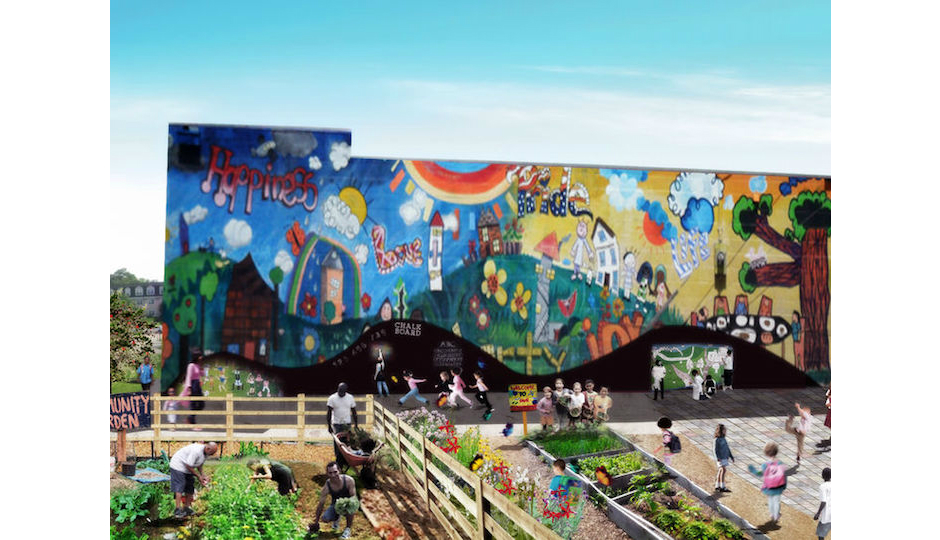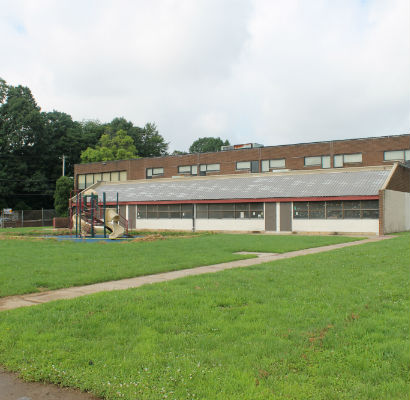From Playgrounds to Play Spaces

One possible future for the Haverford Bright Futures Center playground is this proposal, “Co-Play at Haverford Bright Futures,” one of three finalists for the Mill Creek site. Photos | Courtesy Community Design Collaborative
The last time the Community Design Collaborative ran its Infill Philadelphia design competition, they asked the entrants to get wet. This time, they want them to go out and play.
“Play is a really important component the city of Philadelphia should have in its public spaces for people who raise children,” said Alexa Bosse, program associate at the Collaborative and manager of its Play Space program. “It’s also a way to activate public spaces so people develop community ties.”
The mother of 3-year-old twins knows whereof she speaks. “Even though I lived in my community for a decade before I had kids, the connections I made at the playground were valuable.”
Think Three Bears Park in Society Hill and you have an idea of what the Collaborative would like to see in every city neighborhood. That’s why the organization chose play spaces as the theme for this year’s Infill Philadelphia competition.
“We believe good design strengthens communities,” said Bosse, and for 25 years, the organization and its volunteers have helped nonprofit organizations across the city create good design. For most of those 25 years, nonprofits have sought out the Collaborative’s pro bono services to get their ideas designed, funded and built.
“In 2007 we decided to have a more proactive approach to creating good design for the citizens of Philadelphia,” Bosse said. So instead of waiting for nonprofits to propose ideas, it created Infill Philadelphia to encourage designers to produce their own.
Each biennial competition focuses on a theme, usually a significant public issue, such as food distribution. The theme of the previous Infill design competition in 2012-13, “Soak It Up,” focused on stormwater management, an area where the city was already turning from gray to green solutions to reduce stormwater runoff.

The Haverford Bright Futures Center site today.
“There’s value in play in bringing the community together,” Bosse said. With a boost from the William Penn Foundation, which has expanded its programs to create great public spaces beyond the boundaries of Center City, and support from the Delaware Valley Association for the Education of Young Children, the Collaborative launched its Play Space initiative last summer. The design competition, the initiative’s keystone project, began last September; the organization received 40 submissions from interdisciplinary teams located in 11 U.S. states and five countries, providing proof that “people outside Philadelphia undertstood the value of great public space,” in Bosse’s words.
An expert jury last month whittled the 40 submissions down to nine finalists—three for each of three sites: the Blanche A. Nixon/Cobbs Creek branch of the Free Library of Philadelphia, the Waterloo Recreation Center in West Kensington’s Norris Square neighborhood, and the Haverford Bright Futures early childhood education center in Mill Creek.
The process by which the finalists created and fleshed out their projects was—what else?—collaborative, involving not only the design teams but the sites and members of the communities where their projects may be built. “One of the greatest aspects of all the teams was that they were great combinations of not only designers but educators, community members, planners and cost estimators,” Bosse said. “There were artists from the neighborhood and even neighborhood kids on some of the teams.
“Before issuing the call for proposals, we met with [each] community to learn what the community wanted on the site, so even the teams that were not local had local input.”
The nine finalists now face two more votes. This week, the finalists have installations up at each site for community members to review and vote on. Then, on March 16 at the Academy of Natural Sciences, the finalists will make lightning-round presentations to a jury of local notables in early childhood education, design, public policy and related fields as well as a public audience. Each team will have a little more than six minutes to make their case (20 slides, 20 seconds per slide). “As a presenter, these presentations are hard, but as a member of the public, [watching them] is exciting,” Bosse said. The winner for each site will be named based on a combination of the expert jury’s scores and the votes of the community and the presentation jurors. Each of the three winning finalist teams receives a prize of $10,000.
After that, the hard part begins. “Our goal is for the winning designs to be implemented,” Bosse said. “That involves fundraising, actual design and construction. These are only conceptual designs, so they will need fleshing out into actual construction designs.” Once the projects are built, the CDC hopes other community groups will be inspired to create their own anchor play spaces.
[Updated March 8, 4:16 p.m.]
Follow Sandy Smith on Twitter.


